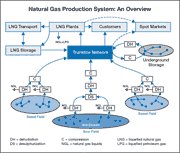MIT math model could aid natural gas production
MIT engineers have developed a mathematical model that could help energy companies produce natural gas more efficiently and ensure a more reliable supply of this valuable fuel. The researchers are now collaborating with experts at Shell to apply the model to a natural gas production system in Malaysia.
Natural gas consumption is expected to increase dramatically in the coming decades. However, in the short term, demand for this clean-burning fuel is highly volatile. Because natural gas is difficult to transport and store, energy companies tend to produce it only when they have buyers lined up and transportation capacity available, frequently under long-term contracts. As a result, they often miss opportunities for short-term sales, and the overall availability of natural gas is reduced.
Natural gas companies would like to operate their production networks more efficiently and flexibly. But operators can be overwhelmed by the sheer number of choices to be made and obligations to be met under supply contracts with customers and facility- and production-sharing agreements with other companies.
According to Professor Paul I. Barton of the Department of Chemical Engineering, the only way for a company to optimize such a system—that is, to operate it so as to best meet all obligations, objectives, and constraints—is to formulate it as a mathematical problem and solve it.
"If there were just one or two decisions to make, an engineer could do it," he said. "But when you've got 20 valves to set and 50 different constraints to satisfy, it's impossible for a person to see. Computer procedures can take all of that into account."
Barton and chemical engineering graduate student Ajay Selot have spent the past two years developing a mathematical model to help guide operators' decisions one to three months in advance. The model focuses on the "upstream supply chain," that is, the system from the natural gas reservoirs to bulk consumers such as power plants, utility companies, and liquefied natural gas plants.
While other models have focused on optimizing individual subsystems, the new MIT model encompasses the whole system. "Ideally, operators would like to make decisions based on information from the entire system," Selot said.
Based on fundamental physical principles, the researchers' model describes gas flow, pressure, and composition inside every pipeline in the network. Equations describe how the flow properties change as the gas passes through each facility along the way. The equations interact so the model can track flows and how they mix throughout the system.
To be useful in the real world, the model must also incorporate—in mathematical terms—the rules from all contracts and agreements. For example, what fraction of production must be shared with other companies?
Operational constraints must also be included. How rapidly can gas be withdrawn from a given well? Further, the company must define its goals, such as maximizing production, minimizing total costs, or scheduling facilities in a particular way.
The final challenge is to "solve the model" so that it defines the specific operating choices that will best satisfy the stated obligations, constraints, and goals. Standard optimization techniques cannot handle such a large and complex model. Selot is therefore refining and extending standard techniques to solve that problem.
He and Barton are now performing a case study of a natural gas production system in Malaysia operated by Sarawak Shell Berhad, Malaysia (SSB). They are working closely with field engineers at SSB and Shell International Exploration and Production, the Netherlands, to build a realistic representation of the Sarawak system—a challenge, as the system is the product of decades of evolution rather than coordinated planning. All of the system's complexity must be reflected in the mathematical model if it is to be of practical value to the Sarawak planners.
—Nancy Stauffer
This research is supported by Shell International Exploration and Production Inc.



